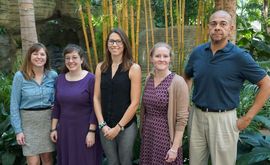LLAMMa: Luisa, Laura, Alexandra, Milton -- looking for new YSOs in Ceph-C, using IR, optical, and X-rays.
This study will be looking for new candidate young stars within the star forming region of Ceph OB3, more specifically in a region of this molecular cloud called Ceph C. Even though this region lies in the galactic plane and is included serendipitously in several large galactic plane surveys, Ceph C has not been well studied in the past, and few young stellar objects (YSOs) have been identified there. The YSOVAR team (Rebull et al. 2014) has time-series monitoring data of this region, and in order to understand the diversity of light curves, it is crucial to understand which objects in the field of view are likely YSOs, and which are foreground/background objects. The goal of our study is to identify candidate YSO sources as well as support the greater understanding of the variety, evolution, and variability of young stars. Our search for young stars will use X-ray, optical, and IR data from Chandra, SDSS, IPHAS, 2MASS, Spitzer (IRAC and MIPS), WISE, Herschel, and the literature (including SCUBA data), giving us a wavelength data range from 0.001 to 850 microns. We will merge the catalogs across all available wavelengths. We will make color-color and color magnitude diagrams for the objects in the region, and use IR colors, X-rays, and variability properties to identify candidate YSOs. We will inspect images (where possible) to ensure good matches across wavelengths and to identify (and remove) resolved galaxies. We will also construct spectral energy distribution diagrams (SEDs) for each candidate YSO in order to better assess whether or not the objects are likely reliable YSOs.
Caltech, Pasadena, California
Many NITARP alumni helped us out with reviewing the NITARP 2016 proposals! Scientists who helped include Chris Gelino, Patrick Lowrance, Rafael Millan-Gabet, Charles Steinhardt, and Sean Carey. Thanks to all!
